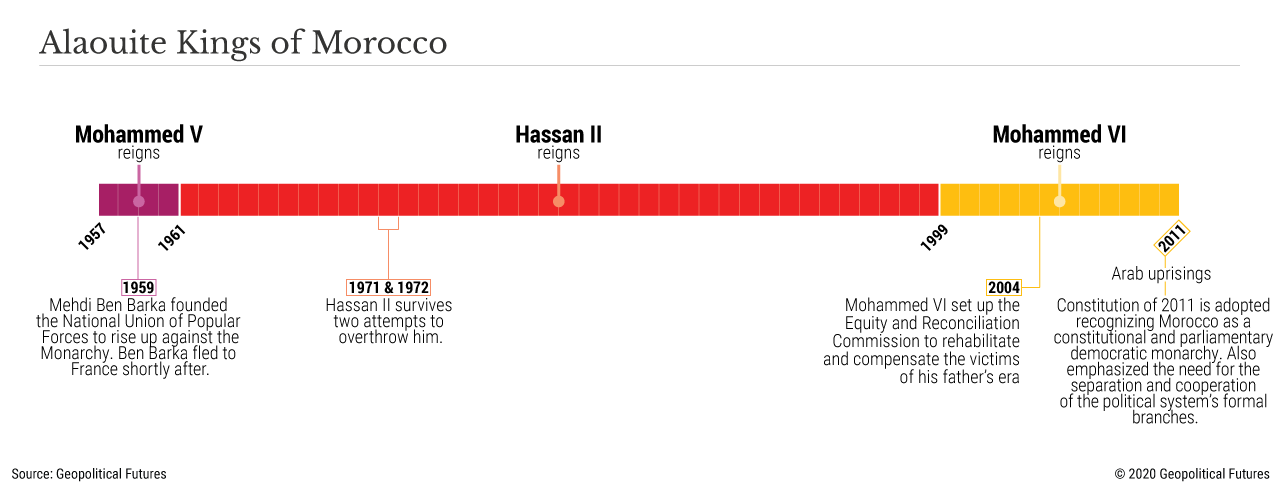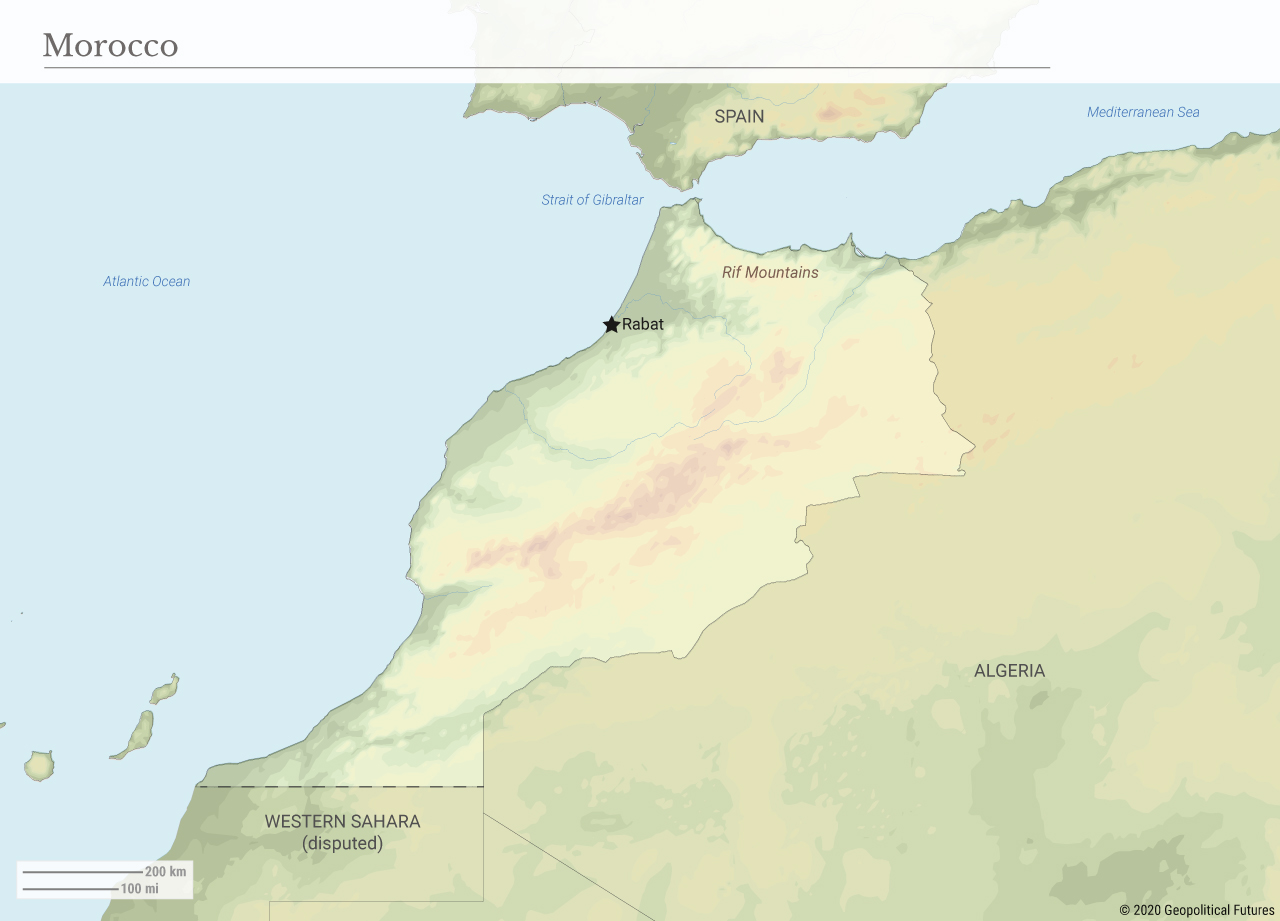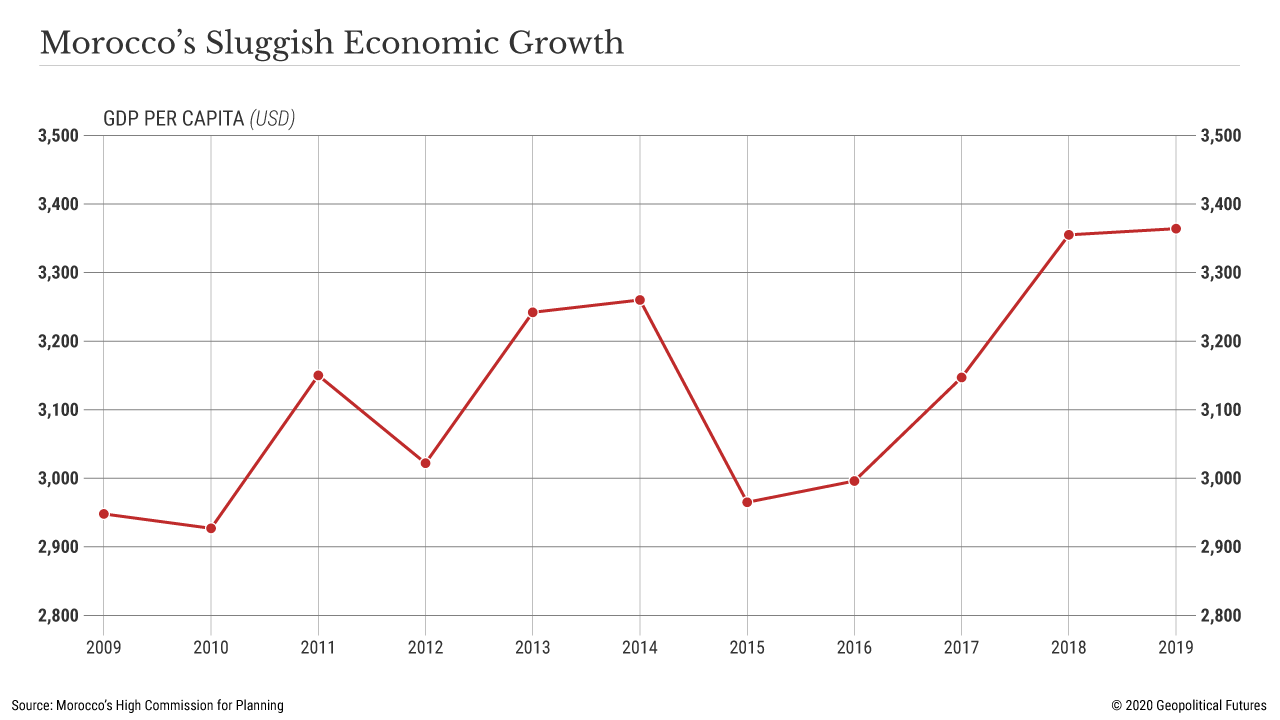|
Morocco is a unique country in the
Middle East and North Africa region. Having been conquered by the Umayyad
Caliphate in the early eighth century, it is the oldest and most
established Arab country. It is also the only Arabic-speaking territory
that the Ottomans failed to conquer. In 1558, the Saadi Arab dynasty, which
ruled Morocco for roughly 100 years, stopped the Ottomans in the Battle of
Wadi al-Laban and forced them to retreat to Algiers. Hailing from Hejaz in
Arabia and claiming to be a descendent of the Prophet Muhammad, Mulay
al-Rashid founded in 1666 the Alaouite dynasty, which continues to rule
Morocco today. Though it became a French protectorate in 1912, Morocco
gained independence in 1956, giving its people hope that it would adopt a
democratic system and begin on a path toward economic development that
would benefit all Moroccans. However, the country failed to make the
necessary changes, and its prospects for growth now look bleak.
Turbulent Start
In 1957, Sultan Mohammed V declared
himself king of Morocco. He died in 1961 and was succeeded by his son,
Crown Prince Hassan II, whose turbulent reign lasted 38 years Two years
after he took over the throne, Morocco claimed sovereignty over Tindouf and
Bechar provinces, which instigated the Sands War with recently independent
Algeria. Hassan also faced a serious challenge at home with the rise of
Mehdi Ben Barka, who in 1959 founded the National Union of Popular Forces
and won international recognition. Hassan accused Ben Barka of scheming to
assassinate him, and strong indicators suggest that he ordered Ben Barka’s
abduction. Disillusioned with Morocco’s democratic transformation and
fearing for his life, Ben Barka sought refuge in France, where he mysteriously
disappeared in 1965.

(click to enlarge)
In the early 1970s, Hassan survived two
attempts to overthrow him. Citing the king’s failure to adopt necessary
reforms, two senior and trusted army officers staged a coup attempt in
1971. A year later, Hassan’s confidant and minister of interior, Mohammed
Oufkir, conspired with the Moroccan air force to shoot down his plane as it
arrived from Paris. These two incidents hardened Hassan, who unleashed an
unprecedented wave of terror against his opponents, including secret
trials, wholesale liquidation of dissidents and widespread arrests of
defectors. Hundreds of extrajudicial executions were carried out and many
more peaceful activists disappeared. The notorious Tazmamart prison, where
dozens of inmates died after being tortured and living in appalling
conditions, became a symbol of the country’s downward spiral. In 1999,
Hassan’s son, Mohammed VI, took over as king and, in 2004, set up the
Equity and Reconciliation Commission to compensate the victims of his
father’s era.
Mohammed VI was well aware of the
difficulties his father encountered while trying to stabilize his regime.
In January 2011, amid the Arab Spring uprisings, he established the Royal
Moroccan Youth Movement to try to preempt protests similar to those that
took place in Tunisia and Egypt. Its members were dubbed el-Ayasha, or
those who say long live the king. It was conceived as a paramilitary
organization and comprised delinquent and uneducated young men whose
primary function was to prevent the emergence of opposition groups. The
movement believed the king was a symbol of national sovereignty and
territorial integrity, and its members promised to give their lives to
defend him. They blamed corruption on the officials surrounding him and
warned fellow Moroccans of the dangers of foreign interference.
Still, the group could not prevent the
emergence in 2011 of the February 20 Youth Movement, which called for
greater freedom and social justice and demanded the introduction of a
parliamentary monarchy. The brief pro-democracy uprising paved the way for
the adoption of the 2011 constitution, which recognized Morocco as a
constitutional and parliamentary democratic monarchy. It also emphasized
the need for separate branches of government and making the wielders of
power accountable to judicial review. The constitution, however, was not
implemented in full and failed to bring the kind of democratic transition
its proponents were hoping for.
The Amazigh Question
Another challenge for modern-day
Morocco is how to integrate the Amazigh, or Berber, ethnic group. The
majority of Amazigh live in northern Morocco, in a region called the Rif. In the 1920s, Abd el-Krim, an iconic Amazigh leader, fought French and
Spanish colonial forces and founded the Republic of the Rif (1921-26). The
Amazigh waged the Taflilat revolt in 1957, and Rif wars continued until
1959.

(click to enlarge)
Inspired by the Amazigh in Algeria, the
Amazigh in Morocco demanded political integration, cultural recognition and
economic development for their communities. But Hassan played a crucial
role in suppressing the Amazigh, and in a 1984 speech in the Rif in
northern Morocco, he described them as bandits, cannabis cultivators and
smugglers and warned them against campaigning for greater autonomy.
Mohammed VI expressed genuine interest
in integrating the Amazigh as long as he did not have to make political
concessions. He created the Royal Institute of Amazigh Culture, made
Amazigh an official language on par with Arabic and opened a Tamazight TV
station. However, little progress has been made on economic development. In
2016, peaceful protests erupted in the Rif region after an Amazigh
fisherman in al-Hoceima, a city on the Mediterranean coast, tried to
retrieve his fish that the authorities had dumped into a garbage truck. The
protests were led by activist Nasser Zefzafi, who was arrested on charges
of threatening national security and given a 20-year prison sentence. Today, thanks to its rugged terrain, the Rif region maintains a de facto
semiautonomous status largely outside the control of the state, except when
the government decides to launch punitive military campaigns.
Future Prospects
Morocco’s progress has been limited in
terms of both political reforms and economic development. Mohammed VI has
not followed through on his promise to introduce political changes. The
king’s supporters say that Morocco will become a parliamentary monarchy if
and when capable political parties and a responsible civil society emerge.
But they also note that it took Britain centuries to institute its
constitutional monarchy and argue that Morocco’s history, its demographics
and regional conflicts mean that the transition will take time. Meanwhile,
Moroccan law still does not allow a single party to win an absolute
majority in the House of Representatives. The king remains in full control,
and parliament is essentially a rubber stamp for the monarch that merely
approves the Cabinet’s bills. The king keeps parties on a tight leash and a
close eye on nongovernmental organizations.
In 2002, 26 political parties ran in
the general election. The top vote-getter, the Socialist Union of Popular
Forces, won just 12 percent of the assembly’s then 325 seats. Instead of
appointing the party's leader, Abderrahmane Youssoufi, as head of the new
government, the king designated Driss Jettou, an independent lawmaker, as the
new prime minister. In the 2016 election, 27 political parties participated
and 15 did not win a single seat. The Justice and Development Party, led by
Abdelilah Benkirane, came in first place with 125 seats, while the
Authenticity Party came in second with 23 seats. After Benkirane failed to
form a Cabinet, the king appointed former Minister of Foreign Affairs
Saadeddine El Othmani as prime minister.
In addition, many of the social reforms
that Mohammed VI introduced after he assumed the throne were not properly
implemented. Changes to the civil code, for example, apply only in theory,
as polygamy and child marriage are still common. The promise of economic
development has given way to stagnation because of bureaucratic lethargy
and poor governance. Public debt exceeds $77 billion, more than 83 percent
of gross domestic product, limiting investment in development projects.
With a per capita income of $3,400, Morocco is the fourth-poorest Arab
country.

(click to enlarge)
Morocco failed to industrialize, and
with economic growth in 2019 at 0.3 percent, it no longer attracts foreign
investors. Several years of drought have weakened the agricultural sector,
and the COVID-19 pandemic has introduced even more hurdles. These
challenges prove that Morocco needs to adopt a new way of thinking about
political and economic development.
|
0 comments:
Publicar un comentario